Japanese exhaust style is your ticket to upgrading your ride with stunning aesthetics and boosted performance. With brands like Yoshimura and HKS, you're looking at enhanced horsepower and torque while enjoying various sound profiles, from aggressive roars to subtle notes. The unique designs, including straight-through systems and custom shapes, not only improve airflow but also give your vehicle a personal touch. These exhausts feature high-quality materials like titanium and stainless steel for durability. If you want to know how to maximize your car's potential and choose the perfect design, you won't want to miss what's next.
Key Takeaways
- Japanese exhaust systems, like those from Yoshimura and HKS, boost horsepower and torque while enhancing fuel efficiency.
- Unique designs, including Bosozoku styles and straight-through configurations, provide both performance benefits and striking aesthetics.
- Adjustable sound profiles, such as valvetronic systems, allow drivers to customize exhaust notes for varying driving experiences.
- High-quality materials like titanium and stainless steel ensure durability and reliability, contributing to long-lasting performance.
- Regular maintenance and proper installation are essential for maximizing the performance and sound of your Japanese exhaust system.
Overview of Japanese Exhaust Style
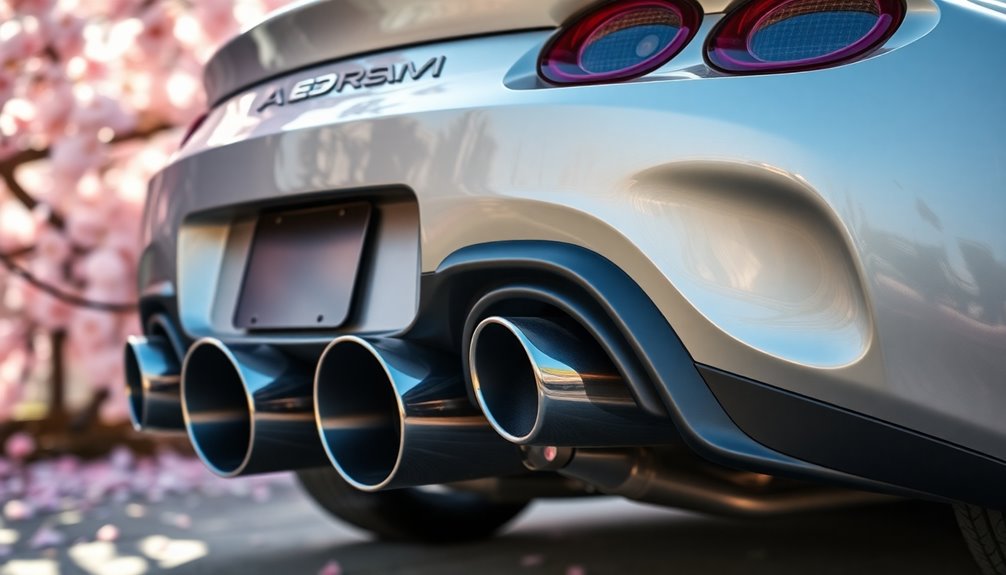
What makes Japanese exhaust style stand out in the automotive world? It's all about precision engineering and meticulous craftsmanship. Japanese manufacturers utilize high-quality materials like titanium and stainless steel, ensuring durability and performance that you can rely on.
Brands like Yoshimura and HKS are at the forefront, known for their innovative designs that not only boost torque and horsepower but also improve fuel efficiency.
You'll appreciate the variety of sound profiles these exhaust systems offer. Whether you prefer an aggressive roar or a more subtle note, there's an option that fits your style.
Plus, many of these systems focus on eco-friendliness, integrating advanced technologies that meet strict emissions standards while still delivering impressive performance.
Customization options are another highlight of Japanese exhaust styles. You can tailor both aesthetics and functionality to suit your personal taste, enhancing the look of your vehicle while improving its performance.
The combination of high-quality materials, innovative design, and a commitment to sustainability sets Japanese exhaust systems apart in the automotive scene, making them a favorite among racers and enthusiasts alike.
Unique Designs and Configurations
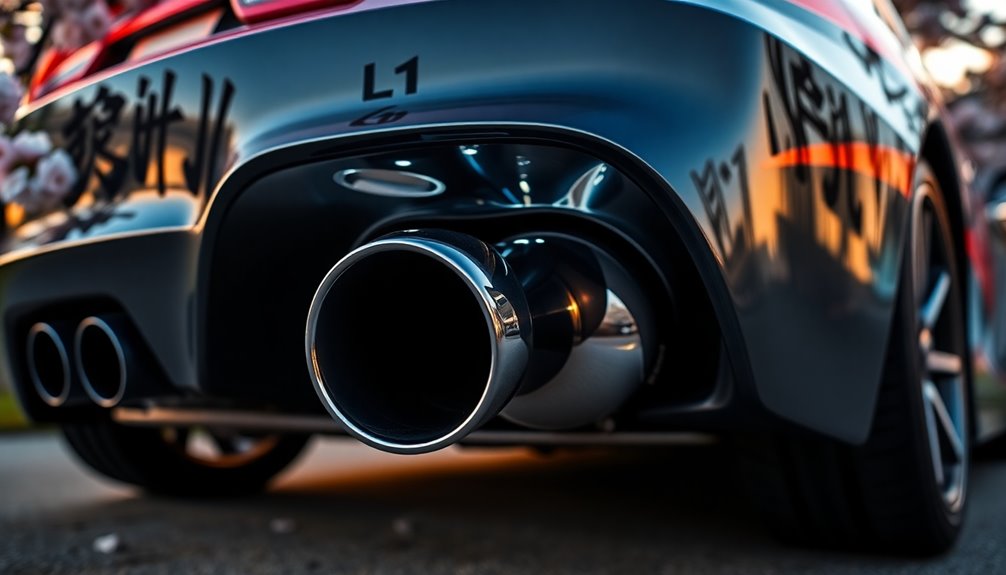
When you explore Japanese exhaust systems, you'll notice their creative shapes and configurations that stand out from the crowd.
These designs not only enhance performance but also allow you to customize sound profiles to match your driving style.
Whether you prefer a subtle purr or a roaring growl, there's an option that fits your preferences perfectly.
Creative Exhaust Shapes
In the world of automotive design, creative exhaust shapes stand out as a tribute to both performance and artistry. Japanese exhaust brands are renowned for their superior quality, delivering unique designs that not only enhance your ride's aesthetic appeal but also its performance.
For instance, Bosozoku-inspired upward-reaching exhausts embody a whimsical rebellion, making a bold statement with exaggerated styling. You might also appreciate the straight-through design found in systems like the MG B-EAST, which emphasizes aggressive aesthetics while ensuring a raw, powerful look.
Such creative exhaust shapes reflect a perfect blend of form and function, enhancing both the visual and auditory aspects of your vehicle. Custom setups, like the exposed dual pipe arrangement in the Mk4 Golf, break conventional norms, allowing you to express your individuality within the car modification culture.
These innovative configurations often use high-quality materials, including titanium and carbon fiber, contributing to lightweight, durable designs that greatly boost airflow and overall performance. By choosing creatively shaped exhausts, you're not just upgrading your vehicle; you're embracing a style that celebrates the art of automotive engineering.
Custom Sound Profiles
Custom sound profiles in Japanese exhaust systems transform your driving experience by tailoring the auditory output to your preferences. Renowned brands like Yoshimura and HKS allow you to select specific sound profiles, ensuring your vehicle resonates with the tone you love—whether that's aggressive or subtle.
Here's a quick comparison of popular custom sound profiles:
| Sound Profile | Description |
|---|---|
| Aggressive | Loud, sporty, and attention-grabbing, perfect for track days. |
| Moderate | Balanced sound, ideal for daily driving with a hint of sportiness. |
| Subtle | Quiet and refined, suitable for a more relaxed driving experience. |
With high-quality materials like titanium and stainless steel, these exhaust systems enhance durability and produce unique sound notes. Innovative valvetronic designs let you adjust the exhaust sound dynamically, giving you the freedom to switch between a robust roar and a peaceful hum as needed. Your choice of custom sound profiles not only elevates performance but also adds a personal touch to your ride's aesthetics. So, immerse yourself in the world of custom sound profiles and experience the difference!
Popular Exhaust Types

Exhaust systems play an essential part in enhancing both the performance and sound of your vehicle, especially in the domain of Japanese cars. If you're looking to boost your ride's capabilities, consider these popular exhaust types.
Cat-back exhaust systems replace everything from the catalytic converter back, improving airflow and offering enhanced performance. You'll often find these on performance-oriented models like the Subaru WRX and Nissan 370Z.
Header exhaust systems, on the other hand, replace factory exhaust manifolds, optimizing exhaust flow and reducing back pressure, which is vital for models like the Honda Civic Type R.
If you want a simpler modification, axle-back exhaust systems focus on replacing components from the rear axle to the exhaust tip, providing a more aggressive sound without major changes.
For those who crave versatility, valvetronic exhaust systems allow you to adjust exhaust flow and sound, appealing to enthusiasts.
Lastly, straight-through exhaust systems maximize exhaust flow with minimal restrictions, making them a favorite in racing applications. This design results in a loud, aggressive exhaust note, perfect for modified Japanese performance cars.
Each option offers unique benefits, so choose the one that best fits your driving style!
High-Performance Brands

High-performance exhaust brands are essential for enthusiasts looking to enhance their vehicle's capabilities and sound. When you choose a reputable brand, you can expect systems that meet high standards in engineering and performance.
Here are three top brands you should consider:
- Yoshimura: Known for precision engineering, Yoshimura exhausts boost torque and horsepower, making them a favorite among motorcycle riders.
- Akrapovič Japan: This brand specializes in lightweight solutions made from premium materials like titanium and carbon fiber, enhancing both performance and aesthetics.
- HKS: Focusing on eco-friendly designs, HKS combines exceptional build quality with innovative engineering, proving that performance and environmental responsibility can coexist.
In addition to these, brands like Two Brothers Japan, known for their aggressive sound profiles, and Beet Japan, celebrated for hand-crafted systems, also uphold high standards in the market.
Each of these brands is dedicated to pushing the limits of performance, ensuring that your ride not only performs exceptionally but also sounds incredible.
Aesthetic Appeal and Sound
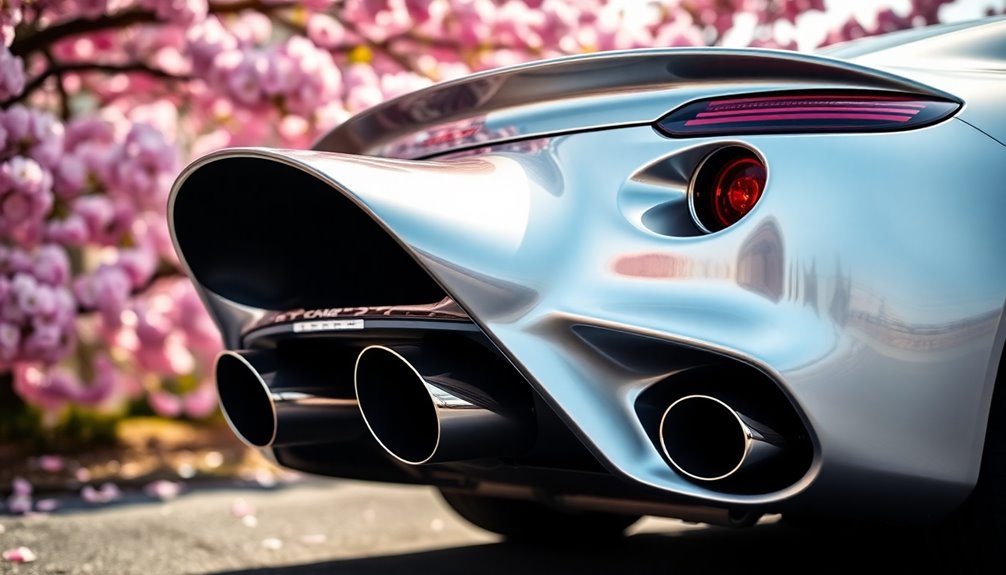
Often, car enthusiasts find that the aesthetic appeal and sound of their vehicle's exhaust system play a crucial role in their overall driving experience. Japanese exhaust systems are celebrated for their precision engineering, which not only enhances performance but also elevates the visual charm of your ride.
Brands like Yoshimura and HKS focus on unique sound characteristics, giving you a distinct auditory experience that's music to your ears. The use of high-quality materials such as titanium and stainless steel guarantees that your exhaust looks striking while remaining lightweight and durable.
These materials contribute to an aesthetic appeal that stands out, whether you're cruising down the street or parked at a car show. Creative designs, like the "upward-reaching" pipes from Bosozoku culture, add a whimsical flair to your vehicle, making it truly one-of-a-kind.
Many Japanese exhaust systems undergo rigorous testing to strike the perfect balance between visual allure and performance. With the right exhaust, you can enjoy a sound profile that not only turns heads but also enhances your driving experience, making every ride memorable.
Installation and Maintenance
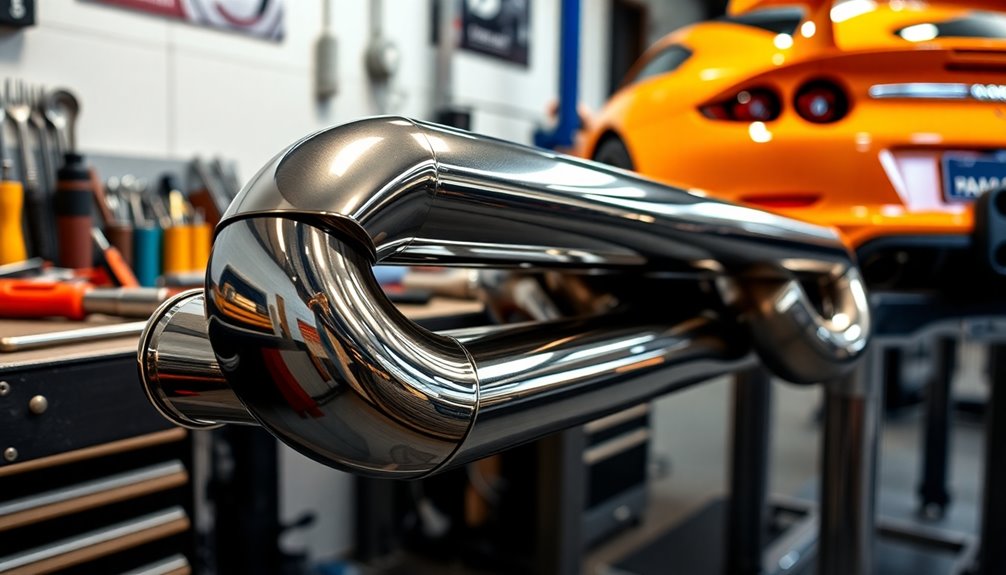
When it comes to upgrading your vehicle's exhaust system, proper installation and maintenance are key to guaranteeing it performs at its best.
Start by gathering the necessary tools, including wrenches, torque spanners, and safety gear, to facilitate a smooth installation process.
Follow these essential steps for a successful installation:
- Detach the Factory Exhaust: Carefully remove the existing exhaust system, noting the mounting locations and hangers to prevent damage during the process.
- Install the New Exhaust: Align the new exhaust according to the manufacturer's guidelines. Confirm all connections are secure to avoid leaks and guarantee peak performance.
- Test Drive: After installation, take your vehicle for a test drive. Listen for any unusual noises and check that the exhaust operates correctly.
Regular maintenance is important too.
Clean the exhaust system, inspect it for signs of wear or damage, and make necessary adjustments.
Staying on top of these tasks will enhance your exhaust's longevity and performance, making certain you get the most out of your Japanese exhaust style upgrade.
Material Quality Considerations
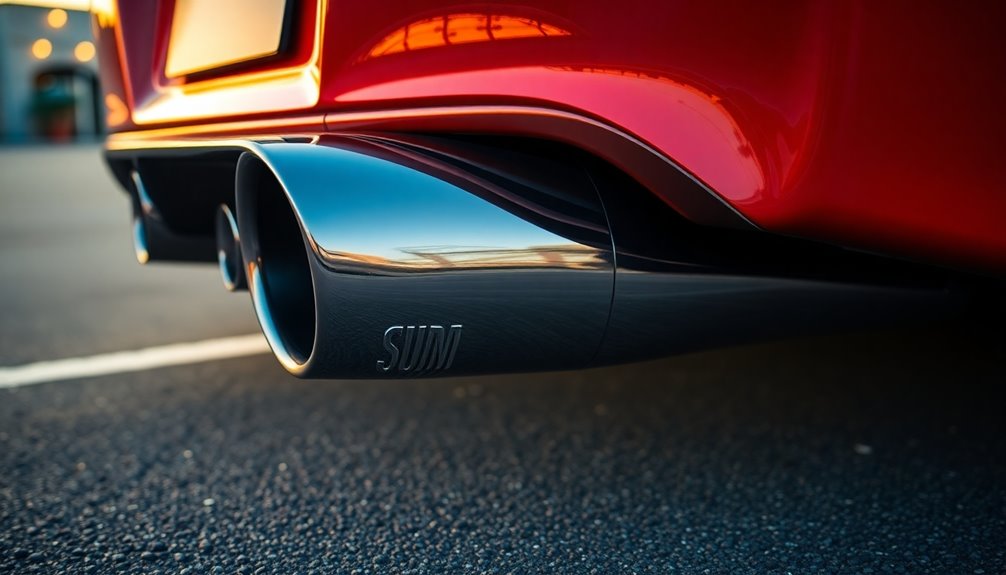
When choosing between titanium and stainless steel for your exhaust system, you'll notice distinct differences in weight and sound profile.
Titanium offers a lightweight design and a unique sound that enhances performance, while stainless steel provides durability and resistance to corrosion, ideal for daily driving.
Understanding these material qualities helps you make the right choice for your vehicle's needs.
Titanium vs. Stainless Steel
Choosing between titanium and stainless steel for your exhaust system involves weighing several important material quality considerations. Each material has its unique benefits that can greatly impact your vehicle's performance and durability.
- Weight: Titanium exhaust systems are considerably lighter, often reducing weight by 40%. This can enhance your vehicle's handling and acceleration.
- Durability: Stainless steel, especially T304 grade, offers excellent corrosion resistance and longevity, making it a great choice for harsh environments.
- Temperature Resistance: Titanium excels in thermal resistance, dissipating heat effectively, while stainless steel can withstand higher temperatures without failing, which is essential for high-performance applications.
While titanium provides a sharper, aggressive sound profile, stainless steel offers a deeper, resonant tone.
However, keep in mind that titanium exhaust systems typically come at a premium price, ranging from 30% to 50% more than stainless options. Additionally, understanding market trends and risks associated with different materials can help you make a more informed decision.
Ultimately, your choice will depend on your priorities—whether it's weight savings, durability, sound preference, or budget.
Consider these factors carefully to enhance your ride with the right exhaust system.
Sound Profile Differences
The choice of material for your exhaust system not only affects weight and durability but also plays a vital role in the sound profile your vehicle produces. Different materials like titanium, stainless steel, and carbon fiber each contribute unique sound profile differences.
For example, titanium often yields a sharper, more aggressive tone, while stainless steel provides a deeper resonance that many drivers find appealing.
The construction quality also impacts sound. High-performance brands such as Yoshimura and Akrapovič Japan use precision engineering to enhance acoustic characteristics, ensuring a more refined auditory experience.
Additionally, the diameter and shape of your exhaust pipes can greatly influence sound. Larger diameter pipes create a louder, more pronounced exhaust note, while specific bends can alter tonal quality.
If you're exploring adjustable sound profiles, consider systems like Fi Exhaust's Valvetronic technology. This allows you to switch between a quieter mode for daily driving and a louder, more aggressive mode for performance.
Cultural Significance in Tuning
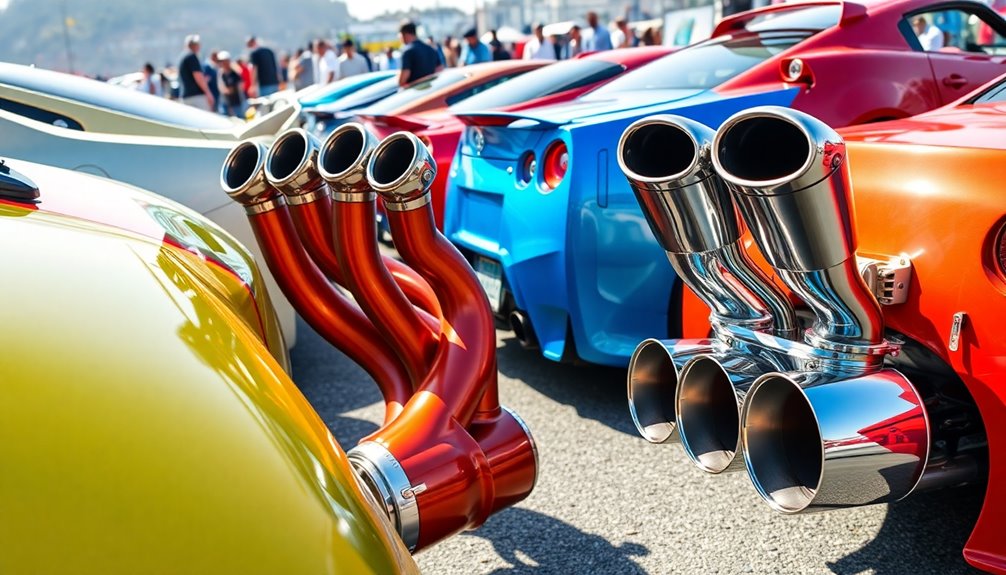
How does the cultural significance of tuning in Japan shape the automotive landscape? Tuning isn't just about performance; it's a vibrant expression of individuality and community. Japanese exhaust designs and modifications reflect a deep-rooted culture that intertwines aesthetics with engineering.
Here are three key aspects of this cultural significance:
- Personal Expression: Your car becomes a canvas, showcasing your style through unique exhaust designs and sound profiles.
- Community Connection: Engaging with fellow enthusiasts fosters camaraderie, where shared passions for tuning and customization unite you with a rich automotive heritage.
- Symbol of Rebellion: Subcultures like Bosozoku highlight the desire for individuality and push against societal norms, encouraging you to stand out in a crowd.
Brands like Yoshimura and HKS epitomize this blend of performance and aesthetics, offering high-quality exhaust systems that resonate globally. The use of premium materials such as titanium and carbon fiber not only enhances durability but also elevates the visual impact and sound signature of your ride. Additionally, the integration of NLP in customer interactions can provide valuable insights into consumer preferences, further influencing design trends in the tuning community.
Embracing the cultural significance of tuning allows you to connect with a vibrant community while expressing your unique identity on the road.
Enhancing Vehicle Performance
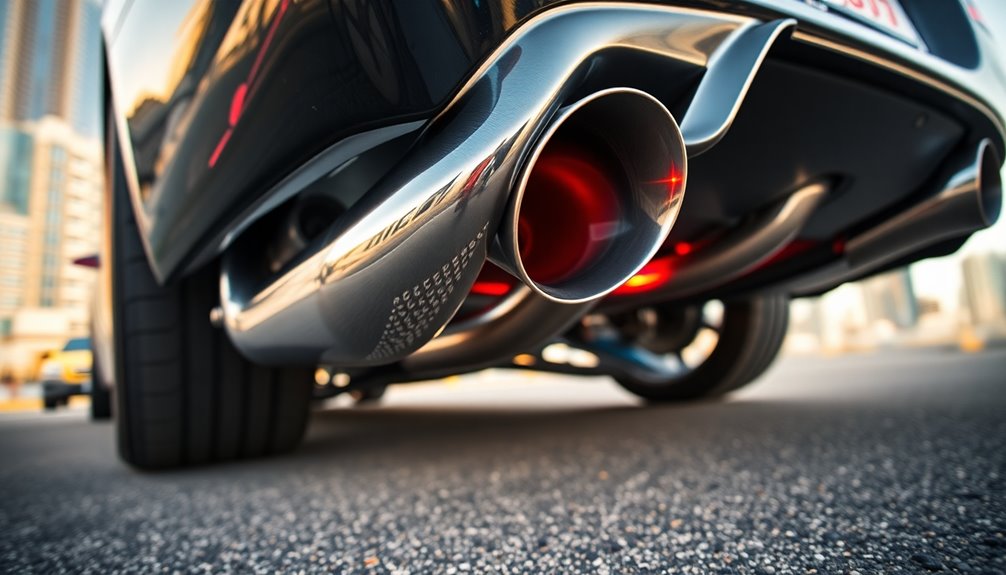
When it comes to enhancing vehicle performance, Japanese exhaust systems stand out for their precision engineering and innovative design. Brands like Yoshimura and HKS focus on optimizing airflow, which translates into significant improvements in torque, horsepower, and fuel efficiency.
By using high-quality materials such as titanium and stainless steel, these exhaust systems not only boost performance but also enhance durability, making them a top choice for enthusiasts and racers alike.
For example, the Fi Exhaust Race Version for the Porsche 992 GT3 RS boasts a remarkable +25 WHP increase without needing an ECU tune. This showcases how a well-engineered exhaust system can deliver measurable gains.
Regular dyno tests validate these performance enhancements, ensuring that every system meets the high expectations of car enthusiasts.
If you're serious about enhancing vehicle performance, investing in a Japanese exhaust system could be the game-changer you need. You'll not only enjoy improved engine efficiency but also a more aggressive sound profile that turns heads.
Ready to take your ride to the next level? Please contact us to learn more about the best options available for your vehicle.
Frequently Asked Questions
What Is the Name of the Crazy Japanese Car Culture?
The crazy Japanese car culture you're thinking of is called "Bosozoku."
It emerged in the 1970s and showcases extreme modifications, like exaggerated body kits and unique exhaust designs.
If you immerse yourself in this culture, you'll find a rebellious spirit, with enthusiasts treating their cars as a canvas for personal expression.
Bosozoku vehicles often feature loud exhaust systems and vibrant paint jobs, making them stand out on the streets and in gatherings.
What Is a Bosozoku Exhaust?
A Bosozoku exhaust is a distinctive type of exhaust system known for its exaggerated, whimsical designs.
When you see those long, upward-reaching pipes, you know it's a Bosozoku style. These exhausts not only produce loud, aggressive sounds but also add a unique flair to your vehicle.
They often incorporate playful elements, resembling fantastical shapes or animals, reflecting a spirit of rebellion and individuality.
You'll definitely make an impression with this eye-catching design!
What Are the Three Types of Exhaust Systems?
So, you wanna plunge into the thrilling world of exhaust systems, huh? Well, buckle up!
You've got three main types to choose from: Cat-Back, which replaces everything from the catalytic converter back, giving you sound and performance; Axle-Back, focusing on that sweet sound without major changes; and Header-Back, the heavyweight champ that includes everything for maximum performance.
Each system's got its charm, so pick your poison and let your ride roar!
How to Design a Good Sounding Exhaust?
To design a good sounding exhaust, start by selecting high-quality materials like stainless steel or titanium for durability and resonance.
Adjust the pipe diameter and length to enhance volume and tune sound frequency.
Choose a muffler that suits your style; straight-through for aggression, or chambered for depth.
Incorporate resonators to refine unwanted frequencies, and consider the exhaust layout for unique sound profiles.
These elements will transform your ride's auditory experience.
Conclusion
As you cruise down the winding roads of your automotive journey, remember that your exhaust isn't just a pipe—it's the voice of your vehicle, singing its unique song. By embracing Japanese exhaust styles, you're not just enhancing performance; you're crafting a symphony of sound and design that reflects your passion. So, let your ride roar like a lion, turning heads and igniting admiration, as you release the true potential of your machine on every adventure.










